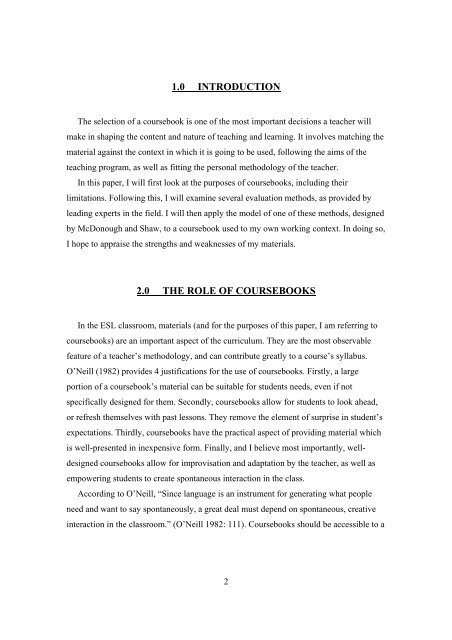A_White_COURSEBOOK_EVALUATION_syll_mat - University of ...
A_White_COURSEBOOK_EVALUATION_syll_mat - University of ...
A_White_COURSEBOOK_EVALUATION_syll_mat - University of ...
Create successful ePaper yourself
Turn your PDF publications into a flip-book with our unique Google optimized e-Paper software.
1.0 INTRODUCTION<br />
The selection <strong>of</strong> a coursebook is one <strong>of</strong> the most important decisions a teacher will<br />
make in shaping the content and nature <strong>of</strong> teaching and learning. It involves <strong>mat</strong>ching the<br />
<strong>mat</strong>erial against the context in which it is going to be used, following the aims <strong>of</strong> the<br />
teaching program, as well as fitting the personal methodology <strong>of</strong> the teacher.<br />
In this paper, I will first look at the purposes <strong>of</strong> coursebooks, including their<br />
limitations. Following this, I will examine several evaluation methods, as provided by<br />
leading experts in the field. I will then apply the model <strong>of</strong> one <strong>of</strong> these methods, designed<br />
by McDonough and Shaw, to a coursebook used to my own working context. In doing so,<br />
I hope to appraise the strengths and weaknesses <strong>of</strong> my <strong>mat</strong>erials.<br />
2.0 THE ROLE OF <strong>COURSEBOOK</strong>S<br />
In the ESL classroom, <strong>mat</strong>erials (and for the purposes <strong>of</strong> this paper, I am referring to<br />
coursebooks) are an important aspect <strong>of</strong> the curriculum. They are the most observable<br />
feature <strong>of</strong> a teacher’s methodology, and can contribute greatly to a course’s <strong>syll</strong>abus.<br />
O’Neill (1982) provides 4 justifications for the use <strong>of</strong> coursebooks. Firstly, a large<br />
portion <strong>of</strong> a coursebook’s <strong>mat</strong>erial can be suitable for students needs, even if not<br />
specifically designed for them. Secondly, coursebooks allow for students to look ahead,<br />
or refresh themselves with past lessons. They remove the element <strong>of</strong> surprise in student’s<br />
expectations. Thirdly, coursebooks have the practical aspect <strong>of</strong> providing <strong>mat</strong>erial which<br />
is well-presented in inexpensive form. Finally, and I believe most importantly, welldesigned<br />
coursebooks allow for improvisation and adaptation by the teacher, as well as<br />
empowering students to create spontaneous interaction in the class.<br />
According to O’Neill, “Since language is an instrument for generating what people<br />
need and want to say spontaneously, a great deal must depend on spontaneous, creative<br />
interaction in the classroom.” (O’Neill 1982: 111). Coursebooks should be accessible to a<br />
2







![Benyamin Asadipour-Farsani [EngD Conference abstract]](https://img.yumpu.com/51622940/1/184x260/benyamin-asadipour-farsani-engd-conference-abstract.jpg?quality=85)









